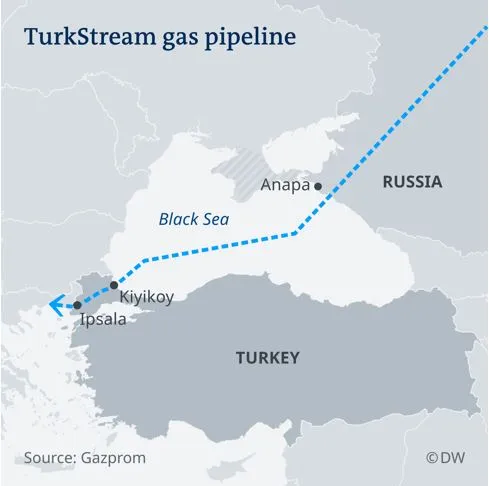

8th May 2025 (11 Topics)
Context
The war in Ukraine has created a major energy crisis in Europe. Since Russia’s invasion in 2022, the European Union (EU) has been trying to reduce its reliance on Russian gas and energy. The EU’s new plan aims to phase out Russian gas completely by 2027, but some EU countries are still buying more Russian energy. The TurkStream pipeline is a key factor in this, as it continues to bring Russian gas into Europe.
EU’s Plan to Stop Buying Russian Gas by 2027
- In response to Russia’s invasion of Ukraine, the European Commission set a goal for the EU to stop importing Russian gas by 2027. This plan asks countries to create their own strategies to reduce gas imports from Russia.
- Although Russian pipeline gas imports have fallen significantly (from over 155 billion cubic meters (Bcm) in 2021 to under 40 Bcm in 2024), Russian LNG (liquefied natural gas) exports to Europe have increased.
- Countries like France, Belgium, Spain, and the Netherlands now buy more LNG directly from Russia.
- S. LNG as an Alternative: The EU is also looking for alternatives to Russian gas. U.S. LNG exports to Europe are expected to increase by 15% in 2025, which could help replace some of the Russian gas.
- However, U.S. LNG is more expensive than Russian gas, and the U.S. requires long-term contracts, which may not align with the EU’s goals to reduce emissions and stay flexible.
- Opposition from Some European Countries
- Hungary and Slovakia are two countries in Central and Eastern Europe that have opposed the EU's plan to phase out Russian gas. These countries argue that it would lead to higher energy prices and hurt their economies.
- Although Russian gas is cheaper, most of the price benefits go to Gazprom, Russia’s state-owned energy company, rather than to European consumers.
What does this mean for the future?
The EU’s efforts to stop using Russian gas face many challenges:
- TurkStream Pipeline: This pipeline remains a key source of Russian gas into Europe. If the EU wants to cut off all Russian energy, it will need to address this pipeline.
- Alternatives: The EU is turning to U.S. LNG as an alternative, but it comes at a higher cost and long-term contracts.
- Energy Security: The EU must find ways to secure enough energy from different suppliers without becoming overly dependent on one source.
About TurkStream Pipeline
 |

